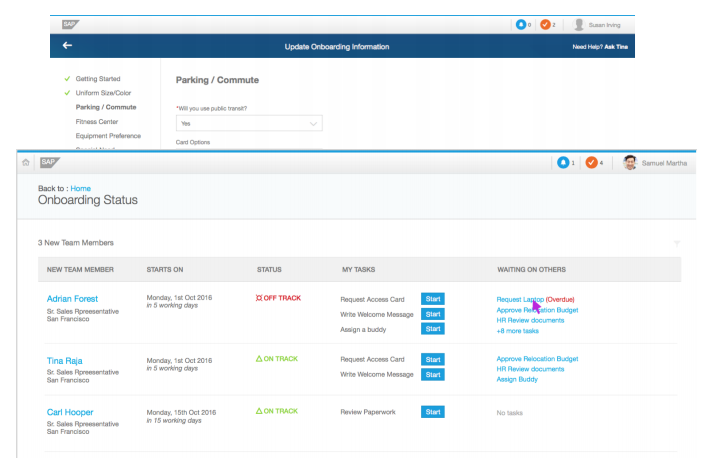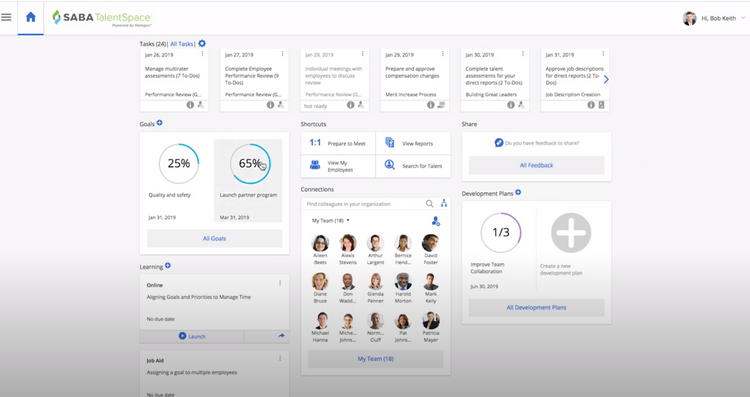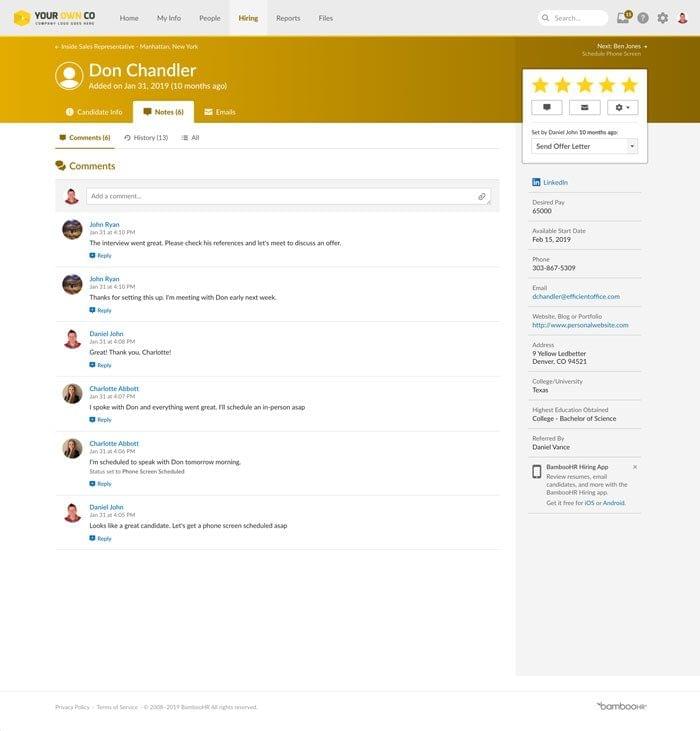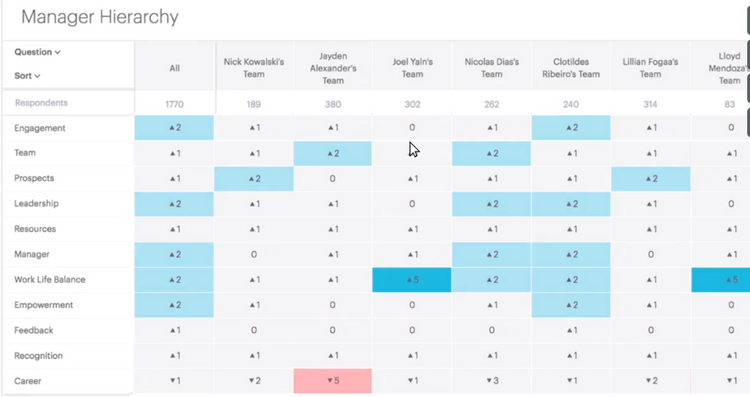The Best Talent Management Software
Get the best software for your business. Compare product reviews, pricing below.
What is a Talent Management Software?
Talent management software is designed to make it easier for companies to attract and develop new talent while motivating and retaining existing employees. This solution covers the employee lifecycle from recruitment and initial onboarding to succession planning and final offboarding. The goal is to provide a company with workers who generate a large return on investment.
Part of human resource management (HR) solutions, talent management tends to focus more on recruitment, retention and motivation of high performing employees like HCM systems. However, unlike HR software, talent management functionality also helps hiring managers by determining who should be promoted based on competency and how to develop long-term succession plans.

Modules of Talent Management Software
- Recruitment and talent acquisition: Ease job sourcing by posting new jobs to popular employment sites and draw in the best possible talent to apply based on employee experience requirements
- Applicant tracking: Organize employee applications submitted to job postings online or in-person; compile candidate experience information for easy recollection and tracking during the hiring process
- Onboarding and offboarding: Integrate new employees into the organization by familiarizing them with the client base and products/services offered; organize learning experiences; correctly handle termination processes
- Core HR processes: Keep information on basic employee data like hiring and start date, compensation benefits, vacation details, and more
- Goal management: Set customizable goals for your company’s performance
- Employee performance management: Tools to monitor and measure employee performance to show who is best contributing to your company
- Performance management: Related to the above, track, analyze, and evaluate individual or team performance based on customizable goal setting
- Time and attendance recording: Track daily or hourly employee clock-ins and clock-outs; track any out-of-office or away-from-desk hours
- Employee analytics: Measure specific employee behaviors and track the results of their work in real-time and over a set work period
- Performance reward/discipline programs: Use reward initiatives to encourage employees to perform well, and create a structure for handling employees who are struggling or not contributing to the bottom line
- Career development: Determine the best future for each employee based on the company’s bottom line and their own skill set
- Compensation calculator: Accurately calculate bonuses and other types of compensation benefits for high performing employees
- Exit interview recording: When an employee parts ways with your company, conduct a formal exit interview to determine what factors influenced their decision and what changes the company could make in the future

Best Talent Management Software Benefits
There are several benefits businesses can enjoy if they use a talent management system:
Attract the Best New Talent
When your company is expanding, you want the best and the brightest to fill new labor roles. Talent management software includes recruitment and acquisition tools to help you reach out to the right people with the right skills. Set clear expectations for your candidates, like previous industry experience and education requirements.
One way to draw in the best talent is to promote all the employee benefits offered by your company. The better your incentive package, the more talented people will want to apply with your than your competitors.
Another tool included with talent management software is an applicant tracking system. This lets your recruiters keep tabs on all job candidates in one platform, no more juggling multiple resumes and misplacing physical applications even when working across multiple job boards. And after hiring, you’ll have a head start on storing the new employee information.

Promote a Healthy Work Culture
Of course, one of the easiest ways to attract new workers and hold on to existing talent is to promote a healthy work culture. Talent management software helps you establish your employer branding to attract the best possible employees and keep the ones you already have. Even something as simple as a mobile app or self-service employee portal for clocking in and out can show workers they have control over their employment.
Your company’s brand will reflect the internal worker culture. If employees are not happy, your brand will suffer and you won’t be able to draw in new talent. Quarterly or annual performance reviews give employees the chance to provide feedback directly to your HR department or management team.
Increase Overall Employee Performance
No one wants to get lost in the shuffle of a repetitive 9-5 job. Once you have new and motivated talent, you can begin to enjoy more productive work by keeping them engaged. One way to improve employee engagement is to reward high performers with incentive programs or offer special bonuses for meeting quarterly goals.
A compensation management system within your talent management software lets you determine payroll changes from these benefits. You can even automate who receives bonuses based on pre-set performance metrics. In turn, this helps you avoid any possible HR conflicts from manually determining additional compensation.
Talent management solutions track worker performance so you can find areas of improvement. If you find consistent problem areas, learning management helps you control the development of your top talent by letting you set up training to address these issues. With a talent management learning and development program in place for new hires, you can ensure all your workers receive the same training.

Make Long-Term Succession Plans
A changeover in management can cause the entire company to dramatically transform. It doesn’t matter if a CEO is stepping down or a long-lasting manager is leaving. Having the right successors in place can assuage fears of unnecessary changes to the corporate structure.
A succession plan is made before an employee announces their plans to retire, resign, or otherwise leave your company. You’ll want a contingency plan in place well before any unexpected resignations or terminations.
How Much is a Talent Management System?
Talent management software pricing depends on several factors, such as whether you want an on-premise system or a cloud-hosted solution. Many SaaS providers charge based on how many employees will be using the software, starting as low as $5 per user per month up to $185 per month. Other perpetual license plans are available for a one-time fee.
How Does Talent Management Differ from Human Resources?
Talent management services often fall into the realm of human resources (HR). Talent management software has more of an emphasis on keeping employees, especially those who offer long-term benefits to the company. With the right talent management solution, you can plan for the expansion of new departments and the replacement of retiring workers.
Human capital management (HCM) is another branch of HR which overlaps with talent management. However, HCM only focuses on recruiting and hiring new employees. There may be some performance management, though it is not necessarily included like it is with talent management software.
Additionally, employee management software focuses on monitoring the performance of existing employees and keeping up their productivity. While talent management offers some tools for rewarding and disciplining workers, it overall is focused on the entire recruiting, acquisition, hiring, and onboarding process. A full HR suite may include HCM, employee management, and talent management, though there are advantages to having separate software depending on the needs of your organization.


